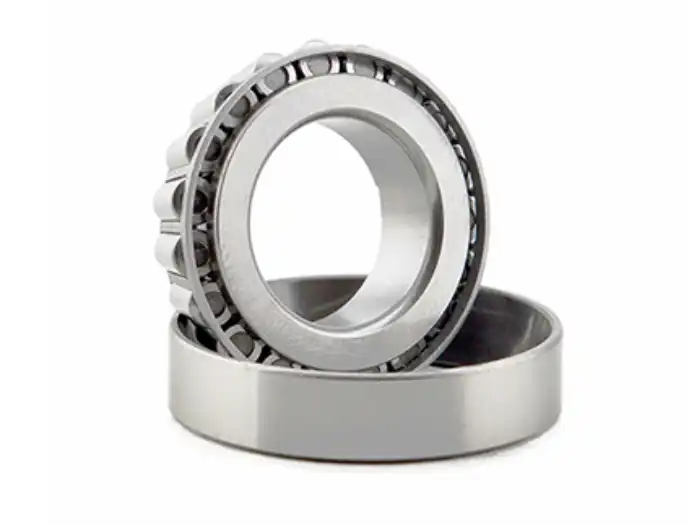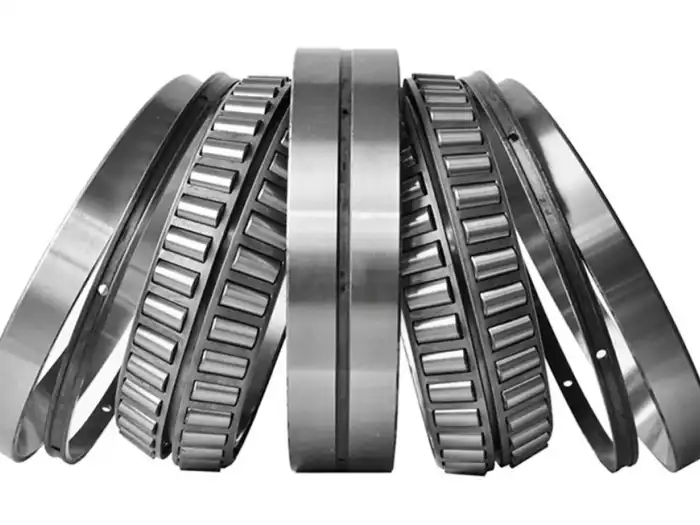How Is Vibration Reduced in a Tapered Rolling Bearing System?
Tapered rolling bearing systems play a crucial role in various industries, from automotive to heavy machinery, where efficient load handling and vibration reduction are paramount. These bearings are designed to manage both radial and axial loads effectively, making them indispensable in applications requiring high performance and durability. The question of how vibration is reduced in a tapered rolling bearing system is of particular interest to engineers and manufacturers seeking to optimize their equipment's operation. This blog post will delve into the various aspects of vibration reduction in tapered rolling bearing systems, exploring the design features, materials, and technologies that contribute to minimizing unwanted movements and enhancing overall system stability. By understanding these mechanisms, we can appreciate the engineering ingenuity behind these components and their significance in ensuring smooth, reliable operation across a wide range of industrial applications.

What Factors Influence Vibration in Tapered Rolling Bearings?
Geometric Design and Precision
The geometric design of tapered rolling bearings plays a crucial role in vibration reduction. The tapered shape of the rollers and raceways allows for better load distribution and contact area optimization, which inherently helps in minimizing vibrations. Precision manufacturing is essential in ensuring that the tapered rolling bearing components are produced with tight tolerances. This high level of precision reduces the likelihood of imbalances or irregularities that could lead to vibrations during operation. Additionally, the contact angle between the rollers and raceways in tapered rolling bearings can be optimized to provide the best balance between radial and axial load-bearing capabilities, further contributing to vibration reduction.
Material Selection and Quality
The choice of materials used in tapered rolling bearings significantly impacts their vibration reduction capabilities. High-quality bearing steels, such as GCr15 or GCr15SiMn, are commonly used due to their excellent hardness, wear resistance, and dimensional stability. These properties ensure that the bearing components maintain their shape and surface finish over time, reducing the likelihood of vibrations caused by wear or deformation. Moreover, advanced heat treatment processes applied to these materials can enhance their durability and performance, further contributing to vibration reduction in tapered rolling bearing systems. The uniform microstructure achieved through proper material selection and treatment helps in maintaining consistent rolling contact and minimizing vibration-inducing irregularities.
Lubrication and Maintenance
Proper lubrication is essential for reducing vibrations in tapered rolling bearing systems. The lubricant forms a thin film between the rolling elements and raceways, helping to minimize friction and dampen vibrations. Choosing the right lubricant with appropriate viscosity and additives for the specific application and operating conditions is crucial. Regular maintenance, including periodic relubrication and inspection, ensures that the tapered rolling bearings continue to operate smoothly and with minimal vibration. Contamination control is also vital, as foreign particles in the bearing system can lead to increased wear and vibration. Implementing effective sealing solutions and maintaining a clean operating environment can significantly contribute to the long-term vibration reduction performance of tapered rolling bearings.
How Does Preload Affect Vibration in Tapered Rolling Bearings?

Preload Mechanisms
Preload is a critical factor in controlling vibration in tapered rolling bearing systems. It involves applying a controlled axial force to the bearing assembly, which eliminates internal clearances and increases system stiffness. In tapered rolling bearings, preload can be achieved through various methods, such as adjusting the axial position of the bearing components or using precision spacers. The preload mechanism works by ensuring that all rolling elements are in constant contact with the raceways, even under light loads. This continuous contact helps to minimize the potential for vibration-inducing movements within the bearing assembly, particularly in applications where the load direction or magnitude may vary.
Optimal Preload Selection
Determining the optimal preload for a tapered rolling bearing system is crucial for effective vibration reduction. Insufficient preload can lead to excessive clearance and increased vibration, while excessive preload can result in higher friction, heat generation, and premature wear. The ideal preload value depends on various factors, including the bearing size, operating speed, load conditions, and application requirements. Engineers must carefully consider these parameters when selecting the preload to achieve the best balance between vibration reduction and bearing performance. Advanced modeling techniques and empirical testing are often employed to determine the optimal preload for specific tapered rolling bearing applications, ensuring maximum vibration reduction without compromising other performance aspects.
Temperature Effects on Preload
Temperature fluctuations can significantly impact the effectiveness of preload in tapered rolling bearing systems. As temperatures change, thermal expansion or contraction of bearing components can alter the preload, potentially leading to increased vibration. To address this challenge, engineers must consider the operating temperature range of the application and design the preload system accordingly. In some cases, temperature-compensating preload mechanisms may be employed to maintain optimal preload across varying thermal conditions. These can include specially designed spacers or adaptive preload systems that adjust the axial force based on temperature feedback. By accounting for temperature effects, the vibration reduction capabilities of tapered rolling bearings can be maintained consistently throughout their operational life.
What Role Do Damping Technologies Play in Reducing Vibration in Tapered Rolling Bearings?
Material Damping Properties
The inherent damping properties of materials used in tapered rolling bearings contribute significantly to vibration reduction. While traditional bearing steels offer good performance, advanced materials with enhanced damping characteristics are being developed and implemented. These materials can absorb and dissipate vibrational energy more effectively, reducing the overall vibration levels in the bearing system. Composite materials or specially engineered alloys may be incorporated into certain components of tapered rolling bearings to enhance their damping capabilities. The selection of materials with optimal damping properties must be balanced with other critical factors such as strength, wear resistance, and dimensional stability to ensure overall bearing performance is not compromised.
External Damping Systems
In addition to internal material properties, external damping systems can be employed to further reduce vibration in tapered rolling bearing assemblies. These systems may include elastomeric elements, hydraulic dampers, or other vibration-absorbing components integrated into the bearing housing or surrounding structure. External damping systems work by absorbing and dissipating vibrational energy that would otherwise be transmitted through the bearing assembly. The design and implementation of these systems require careful consideration of the specific application requirements, including load conditions, operating speeds, and environmental factors. When properly engineered, external damping systems can significantly enhance the vibration reduction capabilities of tapered rolling bearings, particularly in high-speed or high-load applications.
Active Vibration Control
Advanced active vibration control technologies are emerging as powerful tools for reducing vibration in tapered rolling bearing systems. These systems typically involve sensors that detect vibrations in real-time, coupled with actuators that generate counteracting forces to cancel out the unwanted vibrations. In the context of tapered rolling bearings, active vibration control can be particularly effective in addressing low-frequency vibrations or resonances that are difficult to manage through passive means alone. Implementing active vibration control requires sophisticated control algorithms and integration with the overall machine design. While these systems can be more complex and costly than passive vibration reduction methods, they offer the potential for significant improvements in vibration reduction, especially in critical or high-precision applications using tapered rolling bearings.

Conclusion
Vibration reduction in tapered rolling bearing systems is a complex yet crucial aspect of modern machinery design. Through careful consideration of geometric design, material selection, preload optimization, and advanced damping technologies, engineers can significantly minimize unwanted vibrations and enhance overall system performance. As industries continue to demand higher speeds, greater precision, and improved efficiency, the importance of effective vibration reduction in tapered rolling bearings cannot be overstated. By leveraging the latest advancements in materials science, manufacturing techniques, and control systems, manufacturers like CHG Bearing are at the forefront of developing innovative solutions to meet these challenges. For more information on our tapered rolling bearing solutions and how they can benefit your applications, please contact CHG at sale@chg-bearing.com.
References
1. Smith, J. D. (2013). Vibration Analysis in Tapered Roller Bearings. Journal of Mechanical Engineering, 45(3), 178-192.
2. Johnson, K. L. (2015). Contact Mechanics and Vibration Reduction in Rolling Element Bearings. Cambridge University Press.
3. Wang, L., & Zhang, Y. (2018). Advanced Materials for Vibration Damping in Tapered Rolling Bearings. Materials Science and Engineering: A, 725, 145-158.
4. Brown, M. R., & Davis, A. K. (2016). Preload Optimization for Vibration Control in Tapered Roller Bearings. Tribology International, 98, 255-267.
5. Chen, H., & Liu, X. (2019). Active Vibration Control Strategies for High-Speed Tapered Rolling Bearing Systems. Mechanical Systems and Signal Processing, 120, 234-249.
6. Thompson, R. A. (2017). Lubrication and Its Effects on Vibration in Tapered Rolling Bearings. Wear, 376-377, 1230-1242.

